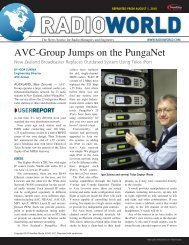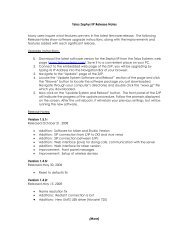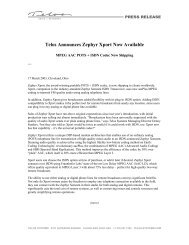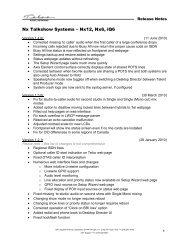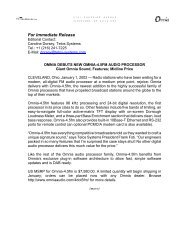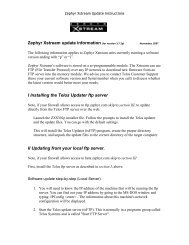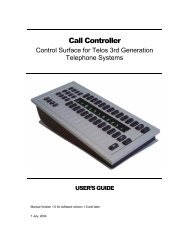NOW! 12-13 - Telos
NOW! 12-13 - Telos
NOW! 12-13 - Telos
You also want an ePaper? Increase the reach of your titles
YUMPU automatically turns print PDFs into web optimized ePapers that Google loves.
TECHTALK BLOG<br />
TELOSALLIANCE.COM/BLOG<br />
BROCHURES<br />
LINEARACOUSTIC.COM/BROCHURES<br />
other devices from other manufacturers will do so as well. So<br />
what are the differences between loudness managers from<br />
Linear Acoustic and others?<br />
While the very deinition of an audio loudness processor requires<br />
that the output measure correctly on a meter, it is not<br />
nearly enough for that to be the only function. The other<br />
critical aspect of a processor is that… it actually sounds good<br />
while maintaining loudness. No meter yet invented can convey<br />
“sounds good”.<br />
The ultimate test of any audio processing device is a listening<br />
session using the best audio evaluation tool in existence, our<br />
human ears. A near ininite list of subtleties exists when processing<br />
signal content with the dynamics of broadcast audio.<br />
Many manufacturers claim to have mastered these subtleties,<br />
but a few listening tests almost always provide a different story.<br />
Imagine a ridiculously extreme example: a loudness processor<br />
could consist of a gain circuit and a clipper. While it would<br />
stick the loudness meter right on the target value, it would be<br />
completely unlistenable.<br />
Sadly this technique is not too far off from some other manufacturers’<br />
current product offerings. Other products are simplistic<br />
wide band gain control circuits that completely ignore<br />
WHITE PAPERS<br />
LINEARACOUSTIC.COM/WHITEPAPERS<br />
the complexities of the human ear. Fletcher and Munson taught<br />
us in the 1930s that our human ears are not at all equally sensitive<br />
to stimuli at different frequencies, and that this response<br />
varies with sound pressure level. Amazingly some designers of<br />
audio loudness processors seem completely unaware of this<br />
work done almost 80 years ago.<br />
So evaluating a loudness processor actually turns out to be a<br />
fairly straightforward process. First, ensure that the candidate<br />
processor will produce the target loudness level over a long<br />
time frame, realizing that there will be short term variations<br />
about the target level due to normal audio dynamics. Almost<br />
every existing processor will achieve this. The next step is quite<br />
simple but will be the real test: listen to the processed outputs<br />
with a wide range of content. Chances are our human ears will<br />
be more revealing than the most in depth data sheet.<br />
Mike Richardson<br />
Director of Products<br />
FIND A DEALER<br />
LINEARACOUSTIC.COM/DEALERS<br />
DTV AUDIO PERFECTION FROM PRODUCTION TO TRANSMISSION<br />
LINEARACOUSTIC.COM<br />
115






